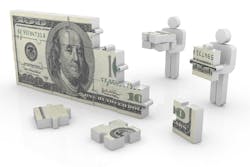Technician bonus systems have always created interesting issues, and in terms of the theory of constraints (TOC), they are generally in direct conflict with the goals of the company. Bonuses for time saved do create efficient departments, however there is a huge cost to the business in doing so, and they often only create a small incremental increase in invoiced work, or throughput. And efficiency in each department is actually very low in the pecking order to achieve greater throughput.
By driving efficiency in a departmentalized structure, we create queues. Because we drive technicians harder, they are always busy, so we end up creating a queuing system by default as each vehicle changes departments and waits for a technician to become free. Every department change, driven by efficiency madness, adds to cycle time. Increased cycle time reduces flow, adds cost, reduces throughput, and increases chaos.
Time-saved bonuses also drive behavior, which is completely in conflict with the goals of the business. They promote greed, selfishness and sloppiness, and reduce reliability (quality). This in turn creates a culture of not wanting to help colleagues. It creates a culture in which work is dragged into the shop, which creates massive work-in-progress (WIP). Plus, if there isn’t much work volume, the company is suffering from loss of profit, yet certain individuals are still earning a fortune in bonus payments.
If we look at team-based bonuses, on the surface, we end up with a better solution, in that the team’s goals are in line with the goals of the business: more throughput equals more bonus and everyone wins. However, team bonuses rely on everyone pulling together for an equal goal, and roughly at the same speed.
Speed differences and attitudes can again cause conflict. Take an example where a member of the team is slow, demoralized or not prepared to pull their weight. Ideally, the rest of the team will pull them along, however, in reality, what happens is that the whole team goes down to the lowest common denominator. On this basis, team bonuses also have their faults. So, how should bonuses be structured?
One of our challenges is that within the complete repair process, we never know how much the repair actually costs us prior to the event. It’s bad enough when parts manufacturers supply at variable rates of discounts. But most importantly, how much will the labor content cost us? This is the greatest variable.
In TOC, we treat labor as a fixed cost, not a variable one against each job. However, if we could really create a bonus system whereby what we pay is fixed, but at the same time we could create an incentive for the technician to produce more, then we really would have a great model.
Well, we can. Here’s how for our productive staff: If we pay based on a fixed rate for the number of hours on the job, then we can understand our cost of repair because it becomes fixed. For instance, if we have a 10-hour job charging out $50 per hour, then our revenue is $500 for labor. If we then pay our staff (say) $15 per hour, the cost of the job is $150. This means we guarantee a labor margin of $350, irrespective of the speed at which they work.
So, if a technician can earn $150 for 10 hours of work, then if they work faster, they can get onto the next job quicker, earning the next fixed-price job. This will directly boost their monthly pay based upon how hard they work. In order for this to work there have to be some rule changes:
It is important to ensure that they cannot start another job until the previous one is completely finished (this stops increased WIP and ultimately improves cycle time). They must also follow these five steps when the vehicle moves to the paint department:
• Clean and organize the work bay
• Carry out sub-assembly work
• Mirror-match parts and sub assemblies
• Study next repair methods for the subsequent job
• Assist the highest priority colleague
A mechanism must also be in place to deal with idle time, when the shop cannot provide work. Idle time can be paid by the hour, and also provides a minimum salary safety net to overcome potential legal and minimum-wage issues.
This system is in exact alignment with the company’s goals and motivates staff to achieve better quality and a better salary, and to drive down cycle time and increase throughput.
Jon Parker is managing director of the Byteback Group, a U.K.-based information technology and services company aimed at advancing the collision repair industry.
